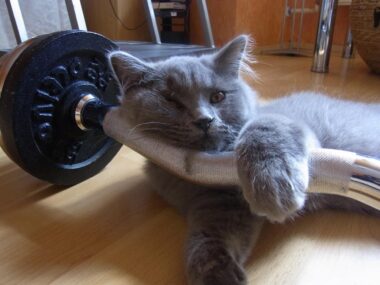Expert Tips for Introducing Target Sticks to Your Cat
When introducing target sticks to your cat, it is essential to create a stress-free environment. Start in a familiar space, ideally where your cat feels safe and secure. You may want to have treats nearby to reward your cat during training. Begin with short training sessions, lasting about five to ten minutes each. This duration helps maintain your cat’s focus and prevents boredom. Pay attention to your cat’s body language, as it can reveal their comfort level with the target stick. If your cat appears stressed or disinterested, consider taking a break or trying again later. Ensure the target stick is engaging; this can mean choosing one with a favorite toy attached. With patience and consistency, your cat can learn to associate the target stick with fun and rewards. Remember to praise your cat verbally and physically, reinforcing positive behavior with gentle touches. Every cat is unique, so adjust your methods based on your observations. For effective training, consider observing progress and modifying techniques accordingly, ultimately fostering a productive learning experience for your feline companion.
Additionally, using positive reinforcement is crucial when training your cat with a target stick. Cats respond best to rewards rather than corrections, so utilize treats and praise generously. After a successful action, such as touching the target, immediately offer a treat to create a positive connection between the action and reward. Over time, your cat will begin to understand the target stick’s purpose, becoming more willing to participate in the training sessions. Remember to keep the experience enjoyable, as a relaxed atmosphere can lead to quicker learning. If your cat struggles at any step, don’t hesitate to simplify your approach or modify the target stick as needed. Another important factor is consistency; practice regularly in similar settings so that your cat can learn expectations. Try setting a regular schedule for training sessions, making this part of the routine they can anticipate. You can integrate playfulness by turning training into a game with a variety of targets. Use different shapes and textures to stimulate your cat’s interest. Always observe and evaluate your cat’s responses to refine your training approach and maximize effectiveness during these sessions.
Gradually Increasing Difficulty
Once your cat is comfortable with the target stick, gradually increase the difficulty level. This can involve using the stick in different environments or challenging your cat to perform actions further away. Start by showing the target stick, letting your cat approach it at their pace. As your cat becomes more confident, you can introduce movements like waving the stick slightly, so they have to follow it. Such activities will help to sharpen your cat’s focus and encourage their engagement. Additionally, you can begin adding cues or commands associated with the target stick to help in the learning process. This might sound like enticing your cat with phrases such as “target” or “touch it” when they interact with the stick. Every time they perform as requested, reward them to reinforce the behavior. Keep adjusting the challenge level based on how your cat responds—if they seem confused, revert back to easier tasks until they regain their confidence. This progression is key as it nurtures growth, skill development, and strengthens the bond between you and your feline partner.
Furthermore, monitoring your cat’s reactions during training is vital for success. Every cat has differing levels of motivation and comfort, so be keenly aware of their cues. If they seem bored or disengaged, consider changing tactics or taking a break. Regularly assess whether the target stick method is still stimulating or changing. Experiment with different rewards, such as treats, praise, or toys, to find what excites your cat most. Providing varied rewards keeps training fresh and engaging, fostering enthusiasm rather than reluctance. You may also want to consider using interactive target stick toys to encourage exploration and playfulness. This way, your cat can learn even when you’re busy or if they’re left alone, making their experiences fun while maintaining a training aspect. Keeping sessions brief is also essential to success; longer duration may lead to frustration, especially if your cat loses stimulation. Always value playtime just as much as training time, ensuring a balance that strengthens the bond, enhances learning, while promoting emotional and physical well-being for your cat.
Incorporating Target Sticks into Daily Life
Once your cat has mastered the basics, consider integrating the target stick into their daily routine. You can play games, encourage exercise, or even use it for behavioral modifications, such as guiding them away from undesirable areas or activities. Consistent use of the target stick can help your cat learn more complex tricks and commands, reinforcing the bond established through training. Be creative with how you utilize the target stick, arranging mini obstacles or sections in your home where your cat can navigate. This encourages mental stimulation and physical movement, both of which are crucial for a happy and healthy cat. You can also involve family members, such as children, making training an enjoyable group activity. However, ensure everyone understands the training techniques to promote consistency. Always follow up with a fun play session as a reward for their hard work, creating a lasting association of positivity and enjoyment. Remember, engaging in training sessions can improve mental well-being and foster healthy behaviors, transforming training with a target stick into a regular fun activity in your household.
Additionally, consider involving your veterinarian in the training process. They can offer insight into your cat’s behavior and health, enhancing your overall approach with the target stick. They may address concerns you have and suggest optimal strategies based on your cat’s personality and needs. Taking your cat’s health into consideration can ensure effective training that respects their physical capabilities. Moreover, a successful training routine can prepare your cat for more advanced activities, such as agility training or participation in cat sports. Those activities not only encourage exercise but also help harness your cat’s innate instincts and bond as a team. Unsurprisingly, many cat owners find target sticks not only aid training but also add joy to daily interactions, acting as a bridge between the owner’s commands and the cat’s natural behaviors. By nurturing this connection, every interaction reinforces positive outcomes, which make the experience rewarding for both the owner and their cat. So, do not put pressure on them but enjoy the journey together, ensuring you celebrate milestones and progress along the way.
Conclusion
In conclusion, target sticks are a remarkable tool for enhancing communication between you and your cat. By following these expert tips, you can create a positive and productive training environment. Start slow and keep it fun, always adapting your techniques to your cat’s comfort level. Remember that patience and consistency are key for long-term success, and adjust your approach as progress develops. Not only does the training engage your cat mentally, but it also strengthens the bond you share, making it a mutually rewarding experience. Ultimately, with dedication and creativity, the training sessions become a highlight rather than a chore. Enjoy the process and celebrate every accomplishment, no matter how small. As time goes on, you may find delightful surprises await you, allowing your cat to demonstrate new skills and behaviors that seem to emerge effortlessly. Therefore, be patient and appreciate the journey, transforming both your lives and enhancing your connection. The use of target sticks will have far-reaching benefits, providing numerous avenues for play, exercise, and joy for both you and your feline friend. Embrace this training method, ensuring the journey is as enriching as its potential outcomes.
Engaging in early socialization is essential; it prepares your cat for enhanced learning dynamics, establishing a solid foundation for future behaviors. Furthermore, appropriate duration and frequency of training sessions contribute significantly; always encourage a playful, enthusiastic atmosphere. When introducing new concepts, such as target sticks, appreciate the unique pace at which your cat may adapt. Be mindful of their evolving needs throughout the training journey, tailoring approaches to suit their development. Collaborative training sessions offer an inclusive experience, enabling various household members to bond through shared activities. Harness the power of observational skills, tuning into your feline’s communication cues during the experience, contributing to more effective learning. This synergy nurtures enjoyment among all participants and transforms training sessions into memorable moments of connection. As time progresses, expect growth and milestone achievements that create rewarding experiences for you both. Don’t hesitate to document progress through photos, videos, or notes; reflecting on these memories can illustrate success stories over time. Lastly, cherish each moment spent together as it enhances the depth of companionship while creating a lasting bond built on trust and mutual understanding.





